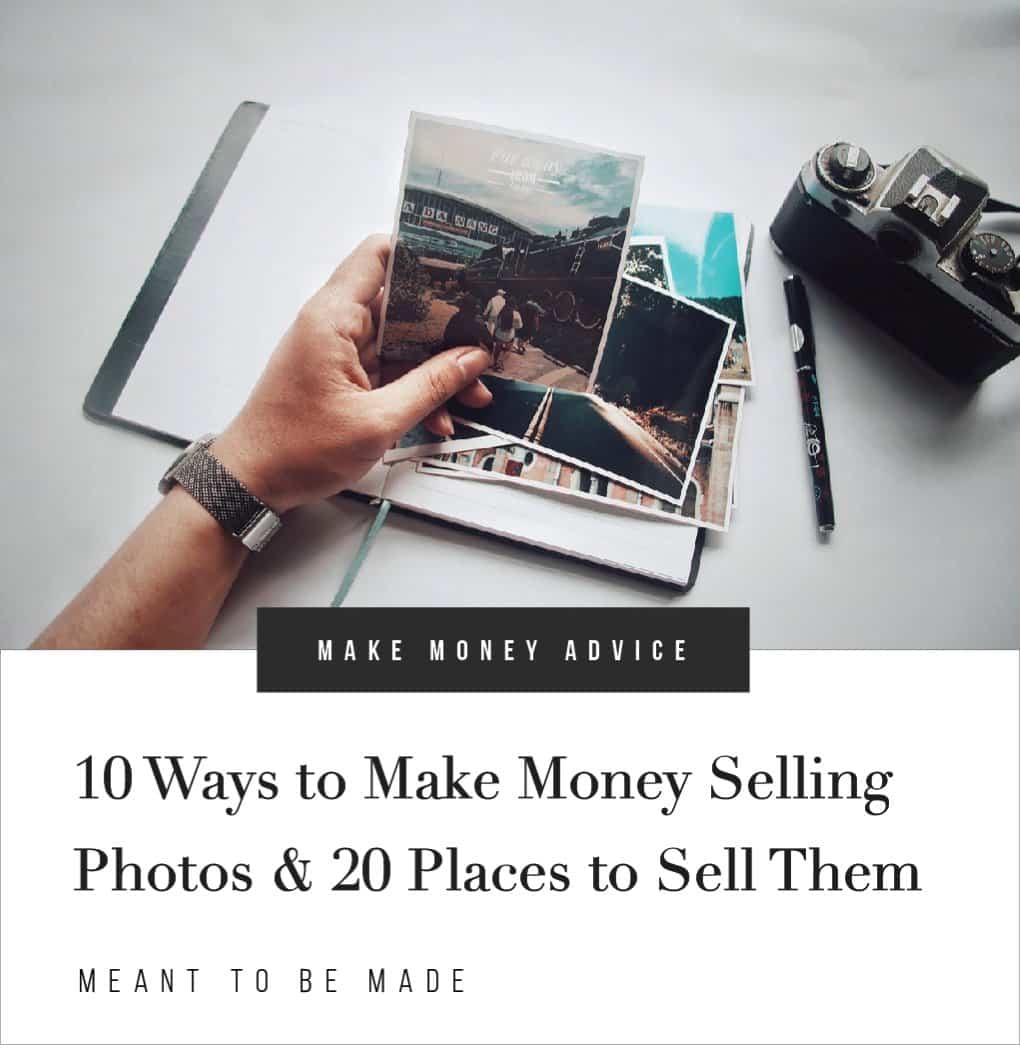Welcome to the exciting world of selling your photos on Getty Images! If you're a passionate photographer looking to monetize your work, Getty provides a fantastic platform to reach a global audience. In this guide, we’ll walk you through the steps to become a successful contributor. Whether you’re capturing breathtaking landscapes, vibrant cityscapes, or candid moments, you can turn your art into income. Let's dive in!
Understanding Getty Images and Its Market

Before you start uploading your photos, it’s crucial to understand what Getty Images is all about. Founded in 1995, Getty is one of the largest and most well-known stock photo agencies in the world. They provide high-quality images to various clients, from major brands to small businesses. Here’s a closer look at what makes Getty a unique marketplace:
- Diverse Clientele: Getty Images caters to a wide range of customers, including advertisers, designers, and media outlets. This diversity opens up numerous opportunities for you.
- Quality over Quantity: Getty is known for its stringent quality standards. They look for imagery that stands out, so ensure your photos are high-resolution and well-composed.
- Royalty-Free vs. Rights-Managed: Understand the difference between these licensing types. Royalty-free images allow clients to use your photos without paying each time, while rights-managed images are sold for specific uses and durations.
To succeed in this competitive market, here are some key points to keep in mind:
- Research Trends: Stay updated on what types of images are in demand. For instance, during the pandemic, images capturing social distancing and remote work became prevalent.
- Know Your Niche: Consider focusing on a specific niche, like food photography, travel, or portraiture. This can help you build a loyal customer base and establish yourself as an expert.
- Keywording: Using the right keywords is essential for your photos to be found. Think like a buyer—what words would they use to search for your image?
In summary, understanding Getty Images and its market dynamics is vital for new sellers. The better you grasp how the platform operates, the more effectively you can tailor your submissions to meet the needs of potential buyers. Keep these insights in mind, and you're one step closer to successfully selling your photos!
Also Read This: How Much Does It Cost to Copyright an Image? A Complete Guide
3. Setting Up Your Account with Getty Images

Alright, let's get started on setting up your account with Getty Images! The first step is to visit their website. You'll want to look for the "Join" or "Sign Up" button, usually found at the top right corner of the homepage. Click on that, and you’ll be taken to the registration page.
Here are a few steps to follow:
- Fill Out Your Details: You’ll need to provide some personal information, such as your name, email address, and a secure password. Make sure to use an email address you check regularly—this will be your main point of communication with Getty.
- Read the Terms: Before you hit that 'Submit' button, take a moment to read Getty's terms and conditions. It’s crucial to understand their policies regarding image rights, exclusivity, and payouts.
- Profile Setup: Once your account is created, you’ll want to set up your profile. This is where you can showcase your style and expertise. Add a short bio, and don’t forget to include links to your portfolio or social media. This helps build trust with potential buyers.
- Verification: Getty Images may send you a verification email to confirm your account. Click on the link provided, and your account will be fully activated!
Now that your account is set up, you’re ready to start uploading images. But wait! Before you jump into that, let’s talk about how to prepare your photos for submission. This step is crucial for ensuring your work stands out in a competitive marketplace.
Also Read This: Can iStock Vectors Be Used for Logos?
4. Preparing Your Photos for Submission
Preparing your photos for submission to Getty Images is like getting ready for a big presentation—first impressions matter! Here’s how to make sure your images shine:
1. Resolution Matters: Getty Images is all about high-quality visuals. Ensure your photos are at least 4 megabytes in size and have a resolution of 300 dpi. This might seem technical, but it ensures your images are sharp and professional.
2. Editing Your Photos: Use editing software to enhance your images. Adjust the brightness, contrast, and sharpness as needed. However, avoid heavy filters or effects that detract from the image’s authenticity.
3. File Format: Save your images in JPEG format, which is the preferred format for Getty. Make sure to keep the original files in case you need to make adjustments later.
4. Metadata is Key: When uploading, include important metadata such as keywords, descriptions, and titles. This information helps buyers find your images. Think about what someone might search for—be specific!
5. Model Releases: If your photos include recognizable people, you’ll need a model release form. This is a legal document that gives you permission to use their likeness commercially. Keep these forms handy, as Getty will require them for submissions.
6. Consider Trends: Research what types of images are currently trending on Getty. For instance, candid lifestyle shots or diverse representations can be very appealing. This doesn’t mean you should compromise your style, but understanding market demand can guide your submissions.
Once your images are ready, it’s time to upload them to your Getty account. But before you do that, give yourself a pat on the back! You’ve taken significant steps toward becoming a successful contributor to one of the largest stock photo agencies in the world. In the next sections, we’ll dive into the submission process and how to maximize your earnings!
Also Read This: How to Cite Getty Images in MLA Format
5. Tips for Choosing the Right Photos to Sell
Choosing the right photos to sell on Getty Images can feel overwhelming at first, especially with the sheer volume of content available. However, there are some key strategies to help you stand out and make your submissions successful. Here are some tips:
- Know the Market: Before snapping your shots, take a moment to browse Getty's current offerings. Pay attention to trending themes, styles, and subjects. This will give you insight into what sells. For instance, in recent months, there has been a strong demand for images that depict remote working environments, wellness activities, and sustainable living.
- Focus on Quality: Ensure your photos are high-resolution and well-composed. Getty Images has strict quality standards. A blurry or poorly lit photo won't make the cut. Invest time in learning photography basics like lighting, composition, and editing techniques.
- Identify Your Niche: What unique perspective do you bring? Specializing in a niche can set you apart from the competition. Whether it's food photography, travel destinations, or urban landscapes, having a distinct style can attract specific buyers.
- Emphasize Authenticity: Buyers tend to favor authentic and relatable images. Candid moments, genuine emotions, and real-life scenarios resonate more than staged shots. For example, if you're photographing families, capturing their natural interactions will likely be more appealing than posed pictures.
- Consider Seasonal Trends: Think ahead about upcoming holidays, events, or seasons. Photos related to Christmas, summer vacations, or back-to-school themes can become highly sought after at specific times of the year.
By keeping these tips in mind, you'll be better equipped to select photos that resonate with buyers and stand out in the Getty catalog. Remember, it's not just about taking pictures; it's about telling a story that connects with viewers.
Also Read This: How to Sell to Getty Images and Become a Successful Contributor
6. Submitting Your Photos for Review
After you've carefully selected and edited your photos, it's time to submit them for review. This step can be crucial for your success on Getty Images, so here’s a straightforward approach to ensure your submission goes smoothly:
- Create an Account: If you haven't already, the first step is to create a contributor account on Getty Images. This process is simple and requires basic information about you and your photography.
- Upload Your Photos: Once you're logged in, you can start uploading your images. Be mindful of the file formats and sizes specified by Getty. Typically, JPEG files with a minimum resolution of 4MP are required.
- Add Metadata: This is where you can shine. Properly tagging your photos with keywords, descriptions, and model releases (if applicable) significantly enhances their discoverability. Think about what potential buyers might search for and include those keywords. For instance, if your photo features a couple enjoying a picnic, you might use tags like "romantic," "outdoor," and "summer picnic."
- Review Submission Guidelines: Before hitting the submit button, double-check Getty's submission guidelines. This ensures you're adhering to their standards and increases your chances of approval. Pay special attention to their rules about model and property releases.
- Be Patient: After submitting, it may take some time for your photos to be reviewed. Getty’s editorial team will assess your work based on quality, relevance, and market demand. Use this waiting period to create more content or improve your skills!
Submitting your photos may feel daunting at first, but following these steps can streamline the process and help you get your work in front of potential buyers. Remember, every photographer started somewhere, and persistence is key!
Also Read This: 123RF Alternatives: Exploring Other Stock Photography Platforms
7. Understanding Licensing and Pricing at Getty Images
As a new seller looking to sell photos to Getty Images, it's crucial to grasp the concepts of licensing and pricing. This knowledge not only helps you set your prices effectively but also ensures you’re aligned with Getty’s practices.
Licensing types play a significant role in how your images are used and how you are compensated. Getty Images operates primarily under two licensing models:
- Royalty-Free (RF): This means once a customer purchases the license, they can use your photo without paying any additional fees for future uses. It's a one-time payment for unlimited use.
- Rights Managed (RM): Under this model, pricing varies based on the usage, duration, and geographical area. It’s more complex but can yield higher returns for exclusive or niche images.
When pricing your photos, consider the following:
- Market Standards: Research similar images on Getty to gauge what others are charging. This will help you position your work competitively.
- Image Quality: High-resolution images with unique compositions or concepts can command higher prices. Always strive for quality!
- Exclusivity: If your image is unique or captures a moment that others haven’t, don’t hesitate to price it higher.
It's also worth noting that Getty Images often updates its pricing structures based on market trends. Stay informed about these changes to maximize your earnings.
Also Read This: 123RF vs Getty Images: Comparing Two Leading Stock Photography Platforms
8. Marketing Your Photos Effectively
Once you’ve uploaded your fabulous photos to Getty Images, the next step is effectively marketing them. While Getty provides a platform, promoting your work can significantly increase visibility and sales.
Here are some actionable strategies to help you market your photos:
- Utilize Social Media: Platforms like Instagram and Pinterest are visual-centric and can help showcase your portfolio. Post regularly, engage with your audience, and use relevant hashtags like #GettyImages and #StockPhotography to reach a broader audience.
- Create a Personal Website: Having a dedicated space for your work allows potential buyers to view your entire portfolio. Include an “About Me” section to tell your story and connect with viewers on a personal level.
- Engage with Photography Communities: Join online forums or local photography clubs. Networking with fellow photographers can open doors to collaborations and referrals.
- Leverage SEO: Use search engine optimization techniques on your personal site. Optimize your image descriptions and tags with keywords that potential buyers might use to search for images.
Remember, consistent marketing is key! Regularly update your portfolio, engage with your audience, and stay active in the photography community. The more you market your work, the more exposure you gain, leading to increased sales on Getty Images.
Also Read This: See How Much Shutterstock’s Cancellation Fee Is
9. Tracking Your Sales and Earnings
Once you've started selling your photos on Getty Images, it's essential to keep an eye on your sales and earnings. Tracking your performance not only helps you understand what’s working but also allows you to make informed decisions for your photography business.
Here are some effective ways to track your sales and earnings:
- Getty Images Dashboard: Your first stop should be the Getty Images contributor dashboard. Here, you can see detailed reports on your downloads, sales, and earnings. Make it a habit to check your dashboard regularly.
- Sales Reports: Getty provides sales reports, usually on a monthly basis. Download these reports to analyze trends over time. Are certain types of photos selling better than others? This information can guide your future shoots.
- Analytics Tools: Use third-party analytics tools to get deeper insights. Tools like Google Analytics can be integrated into your portfolio website if you have one, allowing you to see how visitors interact with your photos.
- Spreadsheets: For those who love data, creating a simple spreadsheet can be a great way to track your earnings over time. Include columns for photo title, date sold, earnings, and client type. This can help you visualize your progress and set future goals.
Tip: Don't just focus on the numbers. Look at what types of content are performing well. Maybe your landscape shots are getting more downloads than portraits. Use this insight to pivot your photography style if needed!
Lastly, set some milestones for yourself. Maybe you want to hit a certain number of sales or earnings by the end of the year. Having goals can motivate you and provide a clear vision for your photography journey.
10. Conclusion: Final Tips for Success on Getty Images
Congratulations! You've made it through the essential steps for becoming a successful seller on Getty Images. As you move forward, keep these final tips in mind to maximize your success:
- Stay Updated: The photography market is always evolving. Keep an eye on trends and popular subjects. Follow industry blogs or join photographer communities to stay informed.
- Quality Over Quantity: While it might be tempting to upload a massive number of photos, focus on quality. High-resolution, well-composed images are more likely to sell.
- Engage with the Community: Don’t hesitate to interact with other photographers. Share experiences, tips, and feedback. Building relationships can lead to collaborations and new opportunities.
- Be Persistent: Remember, success might not come overnight. Stay persistent, keep honing your craft, and continue uploading new content. The more you put yourself out there, the more likely you are to succeed.
In summary, selling photos on Getty Images can be a fulfilling venture. By tracking your sales, engaging with the community, and continuously improving your work, you’ll be well on your way to achieving your photography goals. Happy shooting!
 admin
admin








